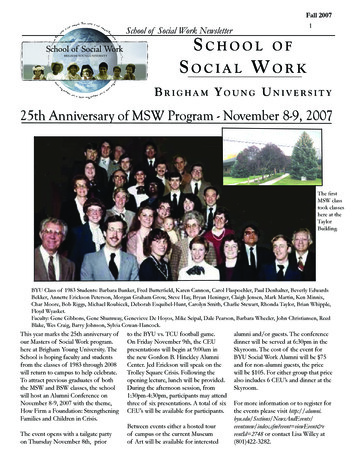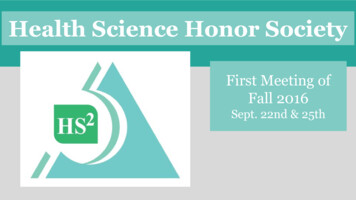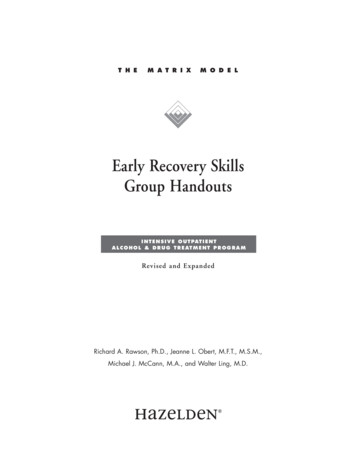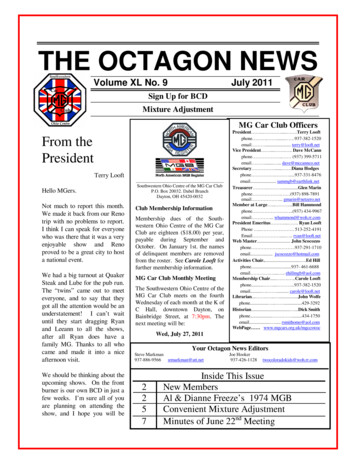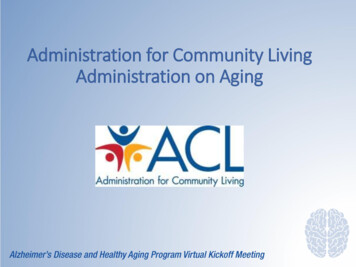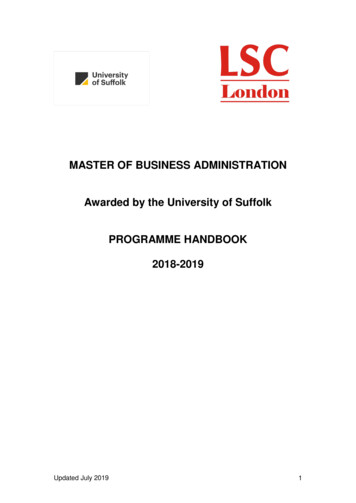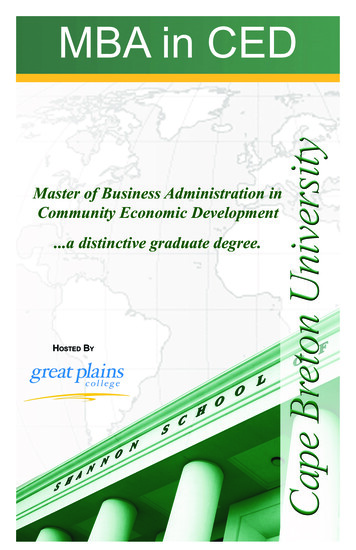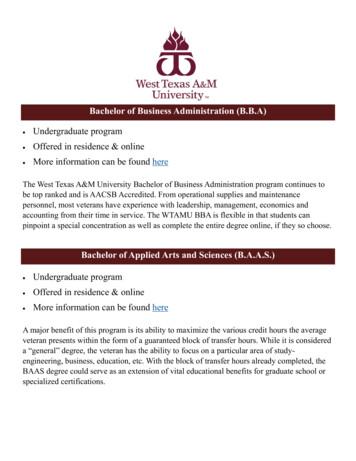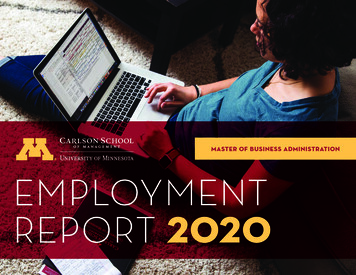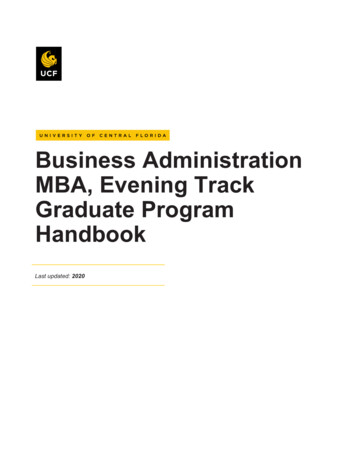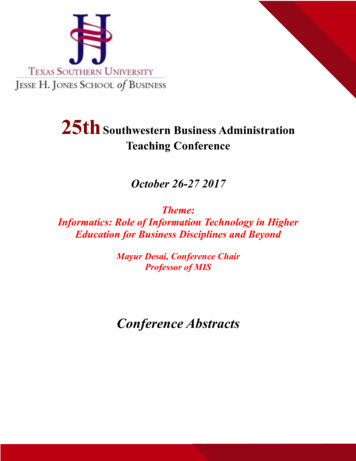
Transcription
25th Southwestern Business AdministrationTeaching ConferenceOctober 26-27 2017Theme:Informatics: Role of Information Technology in HigherEducation for Business Disciplines and BeyondMayur Desai, Conference ChairProfessor of MISConference Abstracts
Keynote SpeakersBrad JensenExecutive Manager,Accenture, Inc.Topic: Informatics: TheGulf Between SkillsPreparation andIndustry Requirements
Andrew MooreChief Operating OfficerTopic: The Democratization of BI: Why BI is the New EmailLuis Villareal, CIO, Texas Southern UniversityChief Information OfficerTopic: Fear and Trembling: Information Technology Fromthe Outside In.
Rethinking Skill Development for Business MajorsChynette NealyProfessor of Business AdministrationUniversity of Houston DowntownMarilyn Davies College of BusinessDepartment of General Business, Marketing & Supply Chain Management320 North Main, Suite B420Houston, Texas 77002Telephone: 713-222-5367Email: nealyc@uhd.eduCorresponding Author: Chynette NealyTopic Area: business skills, pedagogy, technologyPurposeThis proposal examines the impact of integrating technology into our course content andpedagogical strategies. Practitioners suggest that business schools should “rethink” pedagogicalapproaches focusing on skill development rather than content assessment Moshiri & Cardon,2014; AACSB, 2011; Hartman & McCambridge, 2011; Hoover, et al., 2010; Yu, 2010). It isreasonable to speculate whether examining this suggestion would provide useful data whichmight improve learner outcomes in terms of expected industry performance. For example, mostGeneral Business programs are designed for its majors to receive a broad overview offundamental theories and procedures of basic business functions. This interdisciplinary approachis designed to provide majors with core business applications that will enable professionalemployment opportunities within various industry sectors. Graduates with this degree should beable to utilize applicable technological skills required by industry.So, what happens when there is a perception that business majors lack applicable technologicalskills? Should business schools mirror industry and conduct an assessment of core skills orcontent? Can findings be used to justify or develop curriculum material for development of skillsrequired by industry? Should business majors be expected to mirror industry in the developmentof skills? These were some of the questions used to examine how and/or if assessment isbeneficial to close the gap-theory to practice with respect to skills development of businessmajors.
MethodologyThe proposed presentation will discuss Phase Two of a pilot study. Phase One of the studyinvolved development of a survey which examined student perceptions of their incomingtechnology skills via comparison of their perception given performance on a Blackboardassessment prior to taking an online course. With regard to technological readiness, students’perceptions mirrored industry perceptions as not being prepared. The perceptions of potentialemployees should align with employers’ standards. Thus, Phase Two of the study sought toidentify from selected industry representatives those technological skills most needed in theirorganizations.ImplicationsThe author proposes to discuss findings from both phases of the study. The author aims todiscuss these findings from a suggested actions perspective by sharing strategies for reality-basedpractices. These strategies might be useful for rethinking pedagogical approaches focusing skilldevelopment rather than content assessment. Findings will contribute to extant literature relatedto bridging the gap between theory and practice in terms of helping business majors develop andenhance technological knowledge and skills.Abbreviated ReferencesAACSB International – The Association to Advance Collegiate Schools of Business. (2011).Recommendations to AACSB International from the globalization of managementeducation task force. 3, Tampa, FLA. AACSB International.Du-Babcock, B. (2006). Teaching business communication: Past, present, and future. Journal ofBusiness Communication, 43, 253-264.Hartman J. & McCambridge, J. (2011). Optimizing Millennials’ Communication Styles,Business Communication Quarterly, 74, 22-44.Moshiri, F. & Cardon, P. ( 2014). The State of Business Communication Classes: A NationalSurvey, Business and Professional Communication Quarterly, 77, 312-329.Yu, H. (2010). Bring workplace assessment into business communication classrooms: Aproposal to better prepare student for professional workplaces. Business CommunicationQuarterly, 73, (1), 21-3.BioChynette Nealy is a professor of business administration at the University of HoustonDowntown. In her work, she is directly concerned with teaching and researching skills that canbe applied to bridging the gap between theory and practice. Address correspondence to ChynetteNealy, Department of General Business, Marketing & Supply Chain Management, 320 NorthMain, Suite B420, Houston, Texas 77002, Telephone: 713-222-5367, Email: nealyc@uhd.edu
Using Crime Data as an Instructional Tool to Illustrate Business IntelligenceBy:Dr. Ruth Robbins, Professor – Management Information SystemsUniversity of Houston Downtown&Professor Syed Ali, Lecturer – Management Information SystemsUniversity of Houston Downtown&Dr. William Willette, Adjunct Professor – Management Information Systems,University of Houston Downtown.In the Management Information Systems discipline classroom, we are encouraged to provide astudent focused learning environment that focuses on utilizing reality based instruction tools.Examples should be used which incorporate concepts that students can readily comprehend.With this in mind, the City of Houston Uniform Crime Report Statistics data is being utilized in aCollege of Business. In this presentation, we will offer examples which provide illustrationsshowing how this ever changing data provides an instructional landscape that students canreadily recognize. Varying opportunities will be shown which provide reality based instruction.The presentation will explain how spreadsheet and database crime data can be used todemonstrate concepts in an assortment of courses taught in the MIS discipline such as theManagement of Information Systems course, Microcomputer Applications course, Introductionto Database course, and the Business Intelligence course.
In Search of Oil and Gas Using Fracking: A Case StudyAuthor: Sarmistha R. MajumdarTexas Southern UniversityAbstractHydraulic fracturing or fracking is an unconventional method of drilling for oil and natural gas.It uses both vertical and horizontal drilling methods to extract oil and natural gas from the deepseated shale rocks that have been found in parts of Texas and other states in the nation. Whenfracking started in the early 2000s, little was known about its environmental impacts. As a result,fracking has been exempted from many federal regulations. Under the concept of environmentalfederalism, much of the responsibility to regulate fracking has been transferred to the states. Thestates exert greater control on fracking now. This arrangement has made it easier for thelobbyists to influence the state government. The lobbyists have tried to prevent the introductionof stringent regulations and resist amendments to existing ones. With the gradual capture of thestate’s regulatory agency by oil and gas industry’s lobbyists, there exists a state bias towards oiland gas production and less attention to the individuals’ demands for protection from thenegative externalities of fracking.The state’s regulatory agency and local governments’ lackadaisical attitudes towards theenforcement of regulations and discontent among individuals over the negative externalities offracking, have led to opposition against fracking in those communities located at close proximityto fracking sites. Since fracking related opposition vary from one community to another, the caseof a community will be discussed with a focus on a problem that is unique to fracking. In thecase study, the state government and the oil and gas industry’s response would also be discussed.A qualitative methodology will be used to obtain information. The utility of the study lies increation of greater awareness of the impacts of fracking on people’s lives and the need to balanceprivate interests with public ones in the state’s regulatory policy.
Impact of Hurricane Harvey Flooding in Texas Using Geospatial InformaticsMaruthi Sridhar Balaji Bhaskar,Department of Environmental and Interdisciplinary Sciences,Texas Southern University, Houston, TX.AbstractUrban flooding is a hazard that causes major destruction and loss of life. High intense precipitationevents have increased significantly in Houston resulting in frequent river and bayou flooding. Acategory 4, Hurricane Harvey has made landfall on South Texas resulting in heavy precipitationfrom Aug 25 to 29 of 2017. About 1 trillion gallons of water fell across Harris County over a 4day period. This amount of water covers Harris County’s 1,800 square miles with an average of33 inches of water. The long rain event resulted in an average 40inch rainfall across the area asrecorded in several rain gauges and the maximum rainfall of 49.6 inches was recorded near ClearCreek. Historically many of the recent storm events such as Allison, Rita and Ike have causedseveral billion dollars in losses for the Houston-Galveston Region. The objectives of our study areto 1) Process the Geographic Information System (GIS) and satellite data from the pre and postHurricane Harvey event in Houston, Texas and 2) Analyze the satellite imagery to map the natureand pattern of the flooding in Houston-Galveston Region. The GIS data of the study area wasdownloaded and processed from the various publicly available resources such as HoustonGalveston Area Council (HGAC), Texas Commission of Environmental Quality (TCEQ) andTexas Natural Resource Information Systems (TNRIS). The satellite data collected soon after theHarvey flooding event was downloaded and processed using the ERDAS image processingsoftware. The flood plain areas surrounding the Brazos River, Buffalo Bayou and the AddicksBarker reservoirs showed severe inundation. The different watershed areas affected by thecatastrophic flooding in the wake of Hurricane Harvey were mapped and compared with the preflooding event.
Informatics-Role of Information Systems Technology in Higher Education forBusiness Disciplines and BeyondMelissa BaldoLamar UniversityNestled in the Transylvania Alps you won’t find a clan of vampires but you will find the town ofRamnicu Valcea in Romania. This particular town has a nickname among law enforcement:“Hackerville” because it is the capital of cybercrime.1 Cybercrime is a billion-dollar industry andever-growing problem in the global business community.2 With each passing day the list ofmassive data security breaches of businesses grows longer. Breaches by trusted names likeYahoo, Target and Home Depot add to the growing uneasiness of the American public with thesecurity of their information. Recently the S.E.C. announced a breach of their E.D.G.A.R.system which places trillions of dollars at stake, and Equifax, one of the Big Three consumercredit reporting agencies announced a major data breach which could compromise the socialsecurity numbers, drivers licenses and credit cards of millions of Americans. Small businessesare not immune. A recent study by the National Small Business Association reports that 44% ofsmall businesses were victims of cybercrime in 2013.3 That number is likely to grow.Many Universities around the globe have followed the lead of Germany and offer degreeprograms in Informatics. According to the Indiana University School of Informatics andComputing, informatics is the study and application of information technology to the arts,science and professions, and to its use in organizations and society at large.” 4 They further statethat it uses computing to solve the big problems: privacy, security, healthcare, education,poverty, and challenges in our environment.5 Germany has sixty Universities that offer thisdiscipline compared with just 10 Universities in the United States.6 The degree program isinterdisciplinary in nature combining several areas of study and expertise into one.Business Informatics integrates computer science and business administration. Rather thanviewing a company as a whole it involves learning and gathering information about each of itsparts. The idea being that those trained in business informatics can act as a liaison to connectmanagement with the information side of a company. It is the premise of this paper that in orderto remain competitive and to keep data secure companies must become more proficient atapplying business informatics. The importance of understanding how confidential informationflows throughout an organization and determining the risk of leakage cannot be overstated. 7 Inorder to accomplish this critical task people must be educated and trained in this burgeoning fieldof business informatics.This paper will (1) examine the critical problem of cyber security and data breaches in thebusiness community (2) explore how the application of Business Informatics in the cybersecurityfield can provide greater protection for companies from the global hacking community and (3)compare the specific Informatics degree programs at various Universities and evaluate thisgrowing trend.1Bhattacharjee, Y. (2011, January 31). How a Remote Town in Romania Has Become Cybercrime Central.Retrieved September 27, 2017, from https://www.wired.com/2011/01/ff hackerville romania/
2Serrano, A. (2011, September 14). Cyber Crime Pays: A 114 Billion Industry. Retrieved September 27, 2017,from Cyber-Crime-Pays-A-114-Billion-Industry3Year-End Economic Report (Rep.). (2014). National Small Business Association.Indiana University School of Informatics and Computing from idList of universities offering degrees in business informatics. (2017, July 18). Retrieved September 27, 2017, fromhttps://en.wikipedia.org/wiki/List of universities offering degrees in business informaticsIncorporation of Information Technologies in the Development of Higher Education forAccounting ProfessionalsThomas A. Jackson, CPA and Don Holmes, CPAUniversity of Houston DowntownAuthor NoteThomas Jackson is now at the Department of Accounting and International Business, MarilynDavies College of Business, University of Houston Downtown.Don Holmes is now at the Department of Accounting and International Business, Marilyn DaviesCollege of Business, University of Houston Downtown.Correspondence concerning this presentation should be addressed to Thomas A. Jackson, CPA,Department of Accounting and International Business, Marilyn Davies College of Business,University of Houston Downtown, One Main Street – Suite 310L, Houston, TX 77002-1001.Contact: jacksonth@uhd.edu or holmesd@uhd.eduAbstractIs higher education preparing work-ready professionals for accounting careers? The answer tothat question and approaches currently employed by three countries is the core of this report. Fordecades it has been obvious that information technology (IT) is having dramatic impact on theaccounting profession. Virtually every aspect has been affected from financial reporting,auditing, tax, forensic accounting, consulting and internal control. Further, we have just begun toaddress the critical areas of cyber-security and Big Data. Yet preparation of the next generationof accountants by those of us in higher education and public accounting remains imbedded in the“stone-age” of information technology from the viewpoint of those individuals we purport toprepare for success.The issues cannot be successfully addressed by simply adding more courses to thecurriculum. Students already face a daunting course load to achieve their goal of beingadequately prepared for work-force entry. No, an additional course or courses will not get the jobdone. Studies addressed here demonstrate that only by enriching the current curriculum inconcert with the profession and textbook authors and their publishers can the issue of properpreparation be successfully addressed. This presentation will focus only on the role of theeducation community. The role of our partners in this process constitute topics for futurepresentations.The current shortcomings are amplified by the relentless march toward globalization andthe profession’s commitment to accounting standards that are adaptable to the resulting new
realities. To address them effectively will require looking beyond the borders of the UnitedStates into the broader perspective of the global accounting higher education community. To thatend we will examine data and approaches from Greece, Saudi Arabia and Australia in addition tothose used domestically. After reflecting on the information presented, you will see that we arenot alone in facing this dilemma and that there does appear to be successful approach in theprocess of development.ReferencesSeethamraju, Ravi Dr, Information Technologies in Accounting Education (2010). 2010Proceedings. 12. Retrieved ticle 1042&context siged2010Santouridis, Ilias, Incorporating Information Technology into Accounting and Finance HigherEducation Curricula in Greece, Economics and Finance, 7th International Conference, TheEconomies of Balkan and Eastern Europe Countries in the changed world, EBEEC 2015, May 810, 2015, Retrieved 8961 Incorporating Information Technology into Accounting and Finance Higher Education Curricula in GreeceAlfahad, Fahad N., Effectiveness of Using Information Technology in Higher Education in SaudiArabia, Procedia - Social and Behavioral Sciences, Volume 46, 2012, Pages 1268-1278Retrieved from 1877042812014164LaMacchia, Carolyn (Bloomburh & Law, Mark (Bloomburg University of Pennsylvania)Addressing cross-disciplinary accounting and information technology learning through agraduate IT course, Journal of Finance and Accountancy, Volume 19, March, 2015, Retrievedfrom http://www.aabri.com/manuscripts/152249.pdf
Blockchain: the next major disruptor in accounting and financeK. RaghavanTexas Southern UniversityBlockchain could be the next innovation and disruptive technology in finance with the potentialto force organizations in many sectors to change business models, financial processes, tax andlegal responsibilities. It offers major opportunities for organizations to achieve improvedcybersecurity, faster transaction processing, lower costs, and bypassing intermediaries. It canrevolutionize the way taxes are calculated and collected. What is Blockchain? It is a type ofdatabase that holds data and programs in heavily-encrypted 'blocks' of individual transactionsand results of executable files, programs and code. The blocks can only be added and cannot beedited, with each block linked to the previous one making a block chain. It uses a digital ledgerto share and track information related to contracts and transactions, and the records arepermanent, verifiable and secure. Although it is mostly recognized as the technology behind thecryptocurrencies such as bitcoin and ethernum, its potential applications are far beyond thoselimited applications. Some of the applications being considered in the world of finance are inglobal companies in many financial sectors as given below.Depository Trust and Clearing Corp (DTCC) which processes financial transactions plansto use it to reduce the cost of warehousing information on the transactions processed, and pass onthe savings to customers. DTCC is evaluating the technology for replacing or enhancing thecredit default swap (CDS)
Rethinking Skill Development for Business Majors Chynette Nealy Professor of Business Administration University of Houston Downtown Marilyn Davies College of Business Department of General Business, Marketing & Supply Chain Management 320 North Main, Suite B420 Houston, Texas 77002 Telep

